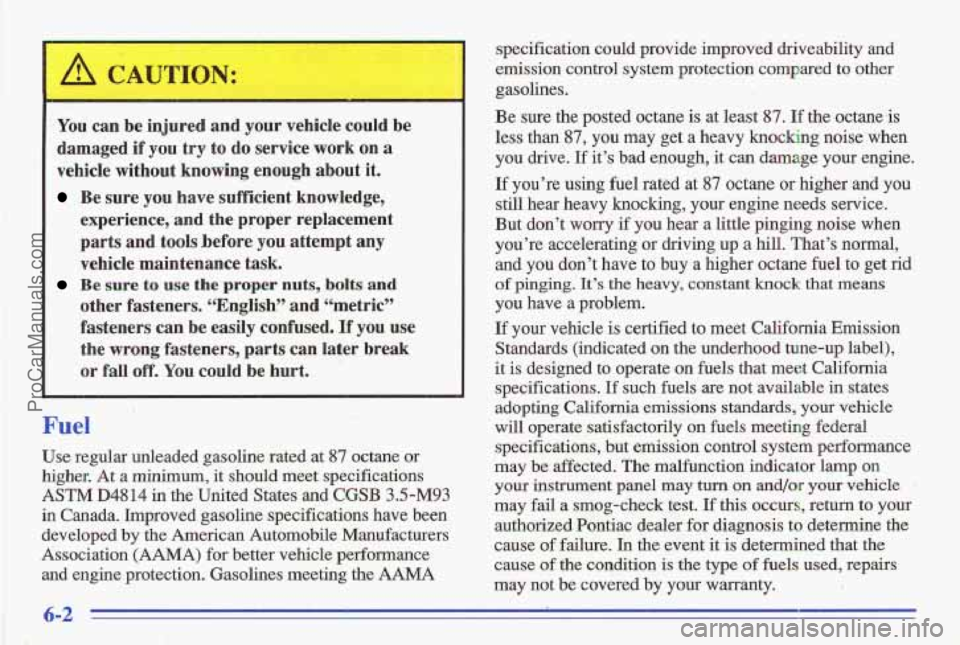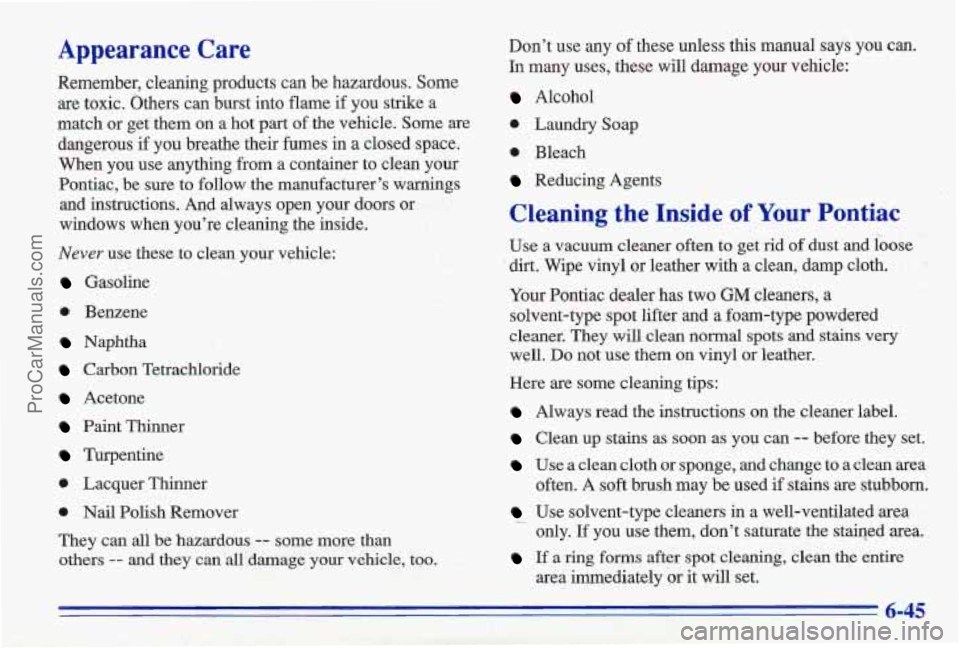Page 224 of 356

A CAUTION:
You can be injured and your vehicle could be
damaged if you try to do service work on a
vehicle without knowing enough about it.
Be sure you have sufficient knowledge,
experience, and the proper replacement
parts and tools before you attempt any
vehicle maintenance task.
Be sure to use the proper nuts, bolts and
other fasteners. “English” and “metric”
fasteners can be easily confused. If
you use
the wrong fasteners, parts can later break
or fall off. You could be hurt.
,, ~
Fuel
Use regular unleaded gasoline rated at 87 octane or
higher.
At a minimum, it should meet specifications
ASTM D4814 in the United States and CGSB 3.5-M93
in Canada. Improved gasoline specifications have been
developed by the American Automobile Manufacturers
Association
(AAMA) for better vehicle performance
and engine protection. Gasolines meeting the AAMA specification could provide improved driveability and
emission control system protection compared to other
gasolines.
Be ,sure the posted octane
is at least 87. If the octane-is
less
than 87, you may get a heavy knocking noise when
you drive. If it’s bad enough, it can damage your engine.
If you’re using fuel rated at 87 octane or higher and you
still hear heavy knocking, your’engine needs service.
But don’t worry if you hear a little pinging noise when
you’re accelerating
or driving up a hill. That’s normal,
and you don’t have to buy a higher octane fuel to get rid
of pinging. It’s the heavy, constant knock that means
you have a problem.
If your vehicle is certified to meet California Emission
Standards (indicated on
the underhood tune-up label),
it is designed to operate
on fuels that meet California
specifications. If such fuels
are not available in states
adopting California
emissions standards, your vehicle
will operate satisfactorily
on fuels meeting federal
specifications, but emission control system performance
may be affected. The malfunction indicator lamp
on
you instrument panel may turn on and/or your vehicle
may fail a smog-check test.
If this occurs, return to your
authorized Pontiac dealer for diagnosis to determine the
cause of failure.
In the event it is determined that the
cause
sf the condition is the type of fuels used, repairs
may not be covered
by your warranty.
ProCarManuals.com
Page 228 of 356
NOTICE:
If you need a new cap, b'e sure to get the right
type.
Your dealer can get one for you. If you get
the wrong type, it may not fit or have proper
venting, and your fuel tank and emissions system
might be
damaged.
Things that burn can get on hot engine parts and
start
a fire. These include liquids like gasoline,
oil, coolant, brake fluid, windshield washer and
other fluids, and plastic
or rubber. You or others
could b'e burned. Be
careful not to drop or spill
things
that will burn onto a hot engine.
Checking "'lings Under the Hood
r
An electric fan under the hood can start up and
injure
you even when the engine is not running.
Keep hands, clothing and tools away from any
underhood electric
fan.
The following sections tell you how to check fluids,
lubricants and important parts underhood.
TO open the hood, first pull
the handle inside the
vehicle.
ProCarManuals.com
Page 255 of 356
Halogen Bulbs
’ I CAUTION:
I
Halogen bulbs have pressurized gas-inside and
can
burst if you drop or scratch the bulb. You or
others could be injured. Be sure to read and
follow the instructions on the bulb package.
Headlamp Bulb Replacement
When replacing the headlamp bulb, do not touch the
glass portion of the new halogen bulb. The oil from your
fingers
will shorten the life of your new halogen bulb.
For the type
of bulb, see “Replacement Bulbs” in the
Index.
1. On the driver’s side only, unscrew the butterfly
2. Remove the attachment bolts of the headlamp
fastener. Then
lift the plate.
support strap.
3. Remove the two headlamp assembly attachment
bolts.
6-33
ProCarManuals.com
Page 267 of 356

Appearance Care Don't use any of these unless this manual says you can.
In many uses, these will damage your vehicle:
Remember, cleaning products can be hazardous. Some
are toxic. others can burst
into flame if you strike a Alcohol
match or get'them on a hot
part of the vehicle. Some are 0 Laundry Soap
dangerous
if you breathe their fumes in a closed space.
When you use anything from a container to clean your
Pontiac, be sure to follow the manufacturer's warnings
Reducing Agents
0 Bleach
and instructions. 'And always open your doors or
windows when you're cleaning the inside.
Never use these to clean your vehicle:
Gasoline
0 Benzene
Naphtha
Carbon Tetrachloride
Acetone
Paint Thinner
Turpentine
0 Lacquer.Thinner
0 Nail Polish Remover
,Cleaning the Inside of Your Pontiac
Use a vacuum cleaner often to 'get rid of dust and loose
dirt. Wipe vinyl or leather with a clean, damp cloth.
Your Pontiac dealer has two
GM cleaners, a
solvent-type spot lifter and a foam-type powdered
cleaner. They will clean normal spots and stains very
well.
Do not use them on vinyl or leather.
Here are some cleaning tips:
Always read the instructions on the cleaner label.
Clean up stains as soon as you can -- before they set.
Use a clean cloth or sponge, and change to a clean area
often. A
soft brush may be used'if stains are stubborn.
Use solvent-type cleaners in a well-ventilated area -
They can all be hazardous -- some more than
others
-- and they can all damage your vehicle, too. If a ring forms after spot cleaning, clean the entire
only. If you use them, don't saturate the staiqed area.
area immediately or it will set.
ProCarManuals.com